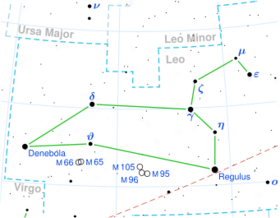Astronomy:Eta Leonis
From HandWiki
Short description: Binary star system in the constellation Leo
| Observation data Equinox J2000.0]] (ICRS) | |
|---|---|
| Constellation | Leo |
| Right ascension | 10h 07m 19.95186s[1] |
| Declination | 16° 45′ 45.592″[1] |
| Apparent magnitude (V) | 3.486[2] |
| Characteristics | |
| Spectral type | A0 Ib[2] |
| U−B color index | −0.206[2] |
| B−V color index | −0.026[2] |
| Astrometry | |
| Radial velocity (Rv) | 1.40[3] km/s |
| Proper motion (μ) | RA: −2.80[1] mas/yr Dec.: −1.82[1] mas/yr |
| Parallax (π) | 2.57 ± 0.16[1] mas |
| Distance | 1,270 ± 80 ly (390 ± 20 pc) |
| Absolute magnitude (MV) | −5.54[4] |
| Details | |
| Mass | 10[5] M☉ |
| Radius | 47[4] R☉ |
| Luminosity | 19,000[5] L☉ |
| Surface gravity (log g) | 2.00[5] cgs |
| Temperature | 9,600[2] K |
| Metallicity | −0.04[4] |
| Rotational velocity (v sin i) | 2[2] km/s |
| Age | 25[5] Myr |
| Other designations | |
| Database references | |
| SIMBAD | data |
Eta Leonis (η Leo, η Leonis) is a fourth-magnitude star in the constellation Leo, about 1,270 light years away.
Properties
Eta Leonis is a white supergiant with the stellar classification A0Ib. Since 1943, the spectrum of this star has served as one of the stable anchor points by which other stars are classified.[6] Though its apparent magnitude is 3.5, making it a relatively dim star to the naked eye, it is nearly 20,000 times more luminous than the Sun, with an absolute magnitude of -5.60. The Hipparcos astrometric data has estimated the distance of Eta Leonis to be roughly 390 parsecs from Earth, or 1,270 light years away.
Eta Leonis is apparently a multiple star system, but the number of components and their separation is uncertain.[7]
References
- ↑ 1.0 1.1 1.2 1.3 1.4 Van Leeuwen, F. (2007). "Validation of the new Hipparcos reduction". Astronomy and Astrophysics 474 (2): 653–664. doi:10.1051/0004-6361:20078357. Bibcode: 2007A&A...474..653V.
- ↑ 2.0 2.1 2.2 2.3 2.4 2.5 Firnstein, M.; Przybilla, N. (2012). "Quantitative spectroscopy of Galactic BA-type supergiants. I. Atmospheric parameters". Astronomy & Astrophysics 543: A80. doi:10.1051/0004-6361/201219034. Bibcode: 2012A&A...543A..80F.
- ↑ Gontcharov, G. A. (2006). "Pulkovo Compilation of Radial Velocities for 35 495 Hipparcos stars in a common system". Astronomy Letters 32 (11): 759–771. doi:10.1134/S1063773706110065. Bibcode: 2006AstL...32..759G.
- ↑ 4.0 4.1 4.2 Przybilla, N.; Butler, K.; Becker, S. R.; Kudritzki, R. P. (2006). "Quantitative spectroscopy of BA-type supergiants". Astronomy and Astrophysics 445 (3): 1099. doi:10.1051/0004-6361:20053832. Bibcode: 2006A&A...445.1099P.
- ↑ 5.0 5.1 5.2 5.3 Tanrıverdi, Taner (2013). "Elemental abundances of the supergiant stars σ Cygnus and η Leonis". New Astronomy 25: 50. doi:10.1016/j.newast.2013.03.013. Bibcode: 2013NewA...25...50T.
- ↑ Garrison, R. F. (December 1993). "Anchor Points for the MK System of Spectral Classification". Bulletin of the American Astronomical Society 25: 1319. Bibcode: 1993AAS...183.1710G.
- ↑ Mason, Brian D. (1996). "ICCD Speckle Observations of Binary Stars.XV.An Investigation of Lunar Occultation Systems". The Astronomical Journal 112: 2260. doi:10.1086/118179. Bibcode: 1996AJ....112.2260M.
External links
- Jim Kaler's Stars: Eta Leonis
 |


